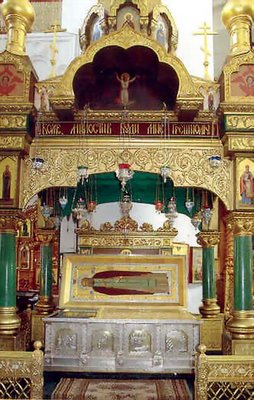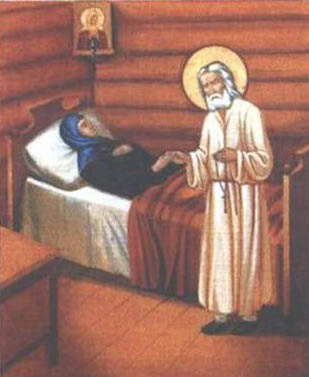
Saint Seraphim of Sarov
[1]
Introduction
St. Seraphim was born to Isidore Ivanovitch and Agathia
Photievna Moshnin on the night of 19-20 July[2]
1759[3]
in Kursk (Курск), Russia.[4]
The name given to him at baptism was Prokhor (Prochoros), after the disciple of
the seventy and companion and co-worker of St. John the Evangelist (28 July and
04 January; cf. Acts 6:1-6). St. Seraphim was raised devoutly by his mother,
his father having died in 1760. Like many saints, various signs in his life as
a child pointed out that he was destined to bring glory to our Lord’s Name in
some special way. At the age of nineteen he joined the Sarov Monastery, and
over the next sixteen years lived a communal life, serving in various
obediences as he grew as a novice to the time of his tonsure, and then to the
ordained as deacon and finally priest. Beginning in 1794 St. Seraphim departed
the community to live for 31 years as a hermit and solitary, undertaking
various ascetic tasks that further prepared him for a ministry to others, when
he would become a brilliant light set on a hill that no one could cover. In
1825 St. Seraphim came out of seclusion and began serving as a true staretz (an elder or spiritual father who functions as venerated adviser and teacher) who
was blessed by God’s Grace with powers such as healing, knowledge, and
foresight, serving those who came to him in great numbers from all walks of
life, as well as his fellow monastics—especially the sisters of the
Diveyevo Convent. On the second of January, 1833, St. Seraphim died at the age of 73 while
kneeling in prayer after serving as a staretz for just over seven years,
although his ministry as a saint certainly continued. On 19 July 1903, the
Church canonized St. Seraphim; in attendance were Tsar Nicholas II, Tsaritsa
Alexandra, the grand dukes, many bishops, and thousands of the faithful who had
flocked to Sarov for the occasion from all across Russia. Saint Seraphim remains
one of the best-loved saints of the Russian Orthodox faithful. At the time of
this writing, the saint’s relics are preserved in the Diveyevo Convent.
Historical Setting
A number of actions taken by Peter “the Great” (reigned
1682-1725) and Catherine II (reigned 1762-1796) changed the face of Orthodoxy
in Russia, and so have some bearing on understanding events in the life of St.
Seraphim.
In the centuries from the
conversion of the Rusę up through the 17th century, the relationship
between the Church and the State followed after the Byzantine role model: a
diarchy represented by the sacerdotium
and imperium. But Peter had no
intent to share his power, nor allow anyone to be in a position to question his
rule. After he took over the conduct of state affairs he began his efforts at Westernizing
Russia.[5]
The patriarch Hadrian openly tried to sabotage the reforms. Peter worked to
neutralize his influence by appointing bishops from Ukraine who were much more
predisposed toward Western habits. When Hadrian died in 1700, Peter seized the
opportunity to remove this thorn from his side. Initially he simply refused to
allow a new patriarch to be elected, and instead appointed a locum
tenens that was sympathetic to his cause.
When he determined that the State could successfully operate without a
patriarch, the office was abolished and replaced by a Synod (a condition that
lasted until 1917) that was nothing more that an organ of the government whose
members were nominated and deposed by the tsar, and who took an oath of
allegiance and obedience to him—i.e., the church “legally” became
subservient to the State.[6]
Peter’s attitude toward the sacerdotium was clearly captured in the regulation
that brought about this change: “The fatherland need not fear from the
synodical administration the same mutiny and disorder as occur under a single
ecclesiastical ruler. For the common people, not knowing the difference between
the spiritual and autocratic power, and being impressed by the greatness and
fame of the supreme pastor, think him a second sovereign, possessing a power
equal or even above that of the autocrat, and believe the church to be another
and higher state. And if the people continue to think this, then what will
occur when the sermons of the ambitious clergymen add fuel to the flame? Those
of simple heart will be so perverted by this idea that they will respect the
supreme pastor more than the autocrat, and if there is discord between the two,
more sympathy will be shown the spiritual ruler than the secular. They will
venture to fight or mutiny for his sake, and deceive themselves into believing
that they are fighting for God Himself and that their hands are not stained but
blessed by the blood that they may shed. Such popular beliefs are of profit to
those who are hostile to the sovereign, and they incite the people to
unlawfulness under the guise of religious fervor. And what if the pastor
himself through self-pride grasped the opportunity?”[7]
Peter was not just happy, however, with subjugating the Church hierarchy, he
wanted to utterly demean it. To this end he established “The Vastly
Extravagant, Supremely Absurd, Omni-Intoxicated Synod” that publicly performed
gross parodies and debaucheries throughout his reign.[8]
Beyond attacks on the hierarchy,
Peter sought to place restrictions on and control the “white” (non-monastic)
clergy. The building of new churches was restricted. Church finances were
controlled to the point that the clergy could not spend even small sums without
the permission of the State. By an edict of 1702, they were required to report
births and deaths weekly.[9]
In 1708, “a secret ukase of the tsar enjoined the clergy to violate the secrecy
of the confession, ‘to diligently question their spiritual children, people of
all ranks, during confession, whether they were going to rebel or had evil
intentions or conspired with any one to rebel or to do harm to the State, or
made plans with anyone to commit brigandage or murder’. If any such ‘evil intention’
was discovered, and it was established that there were plans to ‘put it later
into effect’, the clergy were obliged to report [it] immediately…” thus making
them government informers.[10]
In 1722 they were required to take an oath of allegiance to the emperor,[11]
after which they were obligated to play the role of informant.
The “black” clergy were not immune
from Peter’s attention. In fact, he thought of them as “the origin of
innumerable disorders and disturbances.”[12]
He sought not only to control the source of the Church’s leaders, but to reduce
and even eliminate the influence it had with the people through its extensive
social work. New monasteries were not to be founded without special permission.
Monks were forbidden to live as hermits (it was not until “1822, just over one
hundred years after it had been imposed, [that] the ban on sketes was lifted…”[13]).
Laymen (e.g., sextons, readers, choristers, scribes) were ejected from residing
in the monasteries, and were only allowed to enter during times of the divine
service. Monastics were bound to one monastery, and not allowed to change to
others except under exceptional conditions, and then only with written
authorization. Nuns were forbidden to go out without written permission, and
then only for short periods of time. Novices were not to be received under the
age of forty, nor without the permission of the Tsar. Monks and nuns were not
allowed to have paper and ink in their rooms, being able to write only with
permission and in a special corner of the refectory (common hall).[14]
Catherine II went even further in 1763. She closed down something like 568
monasteries out of the 953 in existence at the time (the actual numbers
reported vary slightly, depending on the source), and greatly reduced the
membership of the ones left open. Her decrees also, not unlike Peter’s, forbid
the profession of new monks and nuns without the express permission of the
central government.
While Peter took steps to destroy
any threat to his rule the Church might have represented through its clergy, at
the same time he also sought to use its resources as an instrument in his
cause. This began at the end of the 17th century by drawing on its
financial wealth through non-repayable loans and grants. By the early 18th
century, all of the Church estates were factually secularized; so two-thirds,
and subsequently as much as seven-eights, of the church revenue was confiscated
and given over to the state.[15]
In the first years after the Church “reform” the government was receiving some
100,000 roubles a year in revenue from church possessions (not counting sums
received from the outright seizure and sale of certain lands, extraordinary
confiscations of church funds and treasuries, or “gifts” it received from some
of the larger monasteries and convents). Catherine II completed this process in
1764 by formally secularizing all church estates.[16]
In spite of all this oppression by
the State against the Church, or rather perhaps because of the “purifying fire”
that such actions produce, Russia experienced a spiritual renewal in the 17th-18th
centuries—a renewal that, in hindsight, can be viewed as a preparation of
the faithful for the terrible persecutions that would soon be brought upon the
land by an antichrist: the Soviet. One measure of the revival that took place
is that the lifting of restrictions against the Church under the Tsars of the
18th century was followed by a rapid growth of the Church; e.g., by
1914 there were 11,845 professed monks and 9,485 novices, and 17,283 professed
nuns and 56,016 novices, and over 300 new monasteries had been founded. But
perhaps more telling spiritually is the list of venerable monks, nuns, and
other saints that appeared during this age. Consider the following sampling: St. Tikhon of Zadonsk (1724-1783); Venerable Father
Paisius Velichkovsky (1722-1794); Bishop Ignatius Brianchaninov (1807-1867);
Bishop Theophan the Recluse (1815-1894); the fathers of Optina, including
Leonid (1769-1841), Macarius (1783-1860), and Ambrose (1812-1891); the fathers
and mystics of Valaam; and the solitaries of the Roslavl forests.[17]
Of course to this list we must add St. Seraphim, the subject of this essay.
Childhood
St. Seraphim (Prokhor) was the third child[18]
of a respected and wealthy, but pious, merchant family. One visible expression
of this family’s piety is found in the fact that St. Seraphim’s father,
Isidore, a stonemason and bricklayer, in 1752 had taken up the task of building
a two-altar church in Kursk (one altar was dedicated to St. Sergius of Radonezh
and the other to Our Lady of Kazan), following the design traditions of the
famous architect Rastrelli. However, Isidore died at the age of 43 in 1760
before its completion. Saint Seraphim’s mother—unwilling to give up or
trust the building to others—took up the task herself, even to the point
of supervising the daily construction activities for the twelve-year period
that was needed to finish the work. To provide for her family, Agathia also
took charge of the family’s brick factory until Alexei, St. Seraphim’s older
brother, was old enough to take over its management. Agathia was respected by
her neighbors for her goodness and for her loving care of the sick, orphans,
and widows; this love for neighbor was inherited by St. Seraphim as he later
revealed when besieged by crowds on all sides. Another expression of Agathia’s
piety was shown when she did not interfere with his stated desire to become a
monk, but rather blessed him with a large copper cross that he wore openly on
his chest even unto death.
God’s Grace was actively at work in
St. Seraphim as a child, as illustrated by the following two incidents:
Like any child, St. Seraphim often
followed his mother around, and so one day at the age of seven, when Agathia’s
church construction oversight activities took her to the top floor of the bell
tower, he naturally went along. However, while she was busy instructing the
workmen, St. Seraphim’s curiosity enticed him too close to the edge of the
platform, and he fell to the ground. Agathia, rushing down the stairs to the
ground, had her dread turned into astonishment when she found her son standing
on his feet, whole and unharmed. A Fool-for-Christ living in Kursk witnessed
the incident and remarked that the child must surely be one of God’s elect.[19]
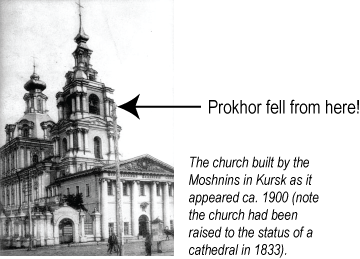 |
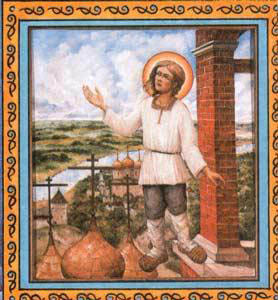 |
 |
On another occasion at the age of ten, St. Seraphim had become
very ill. The Mother of God, in what was her first—at least visible—visitation to St.
Seraphim, promised to heal him.
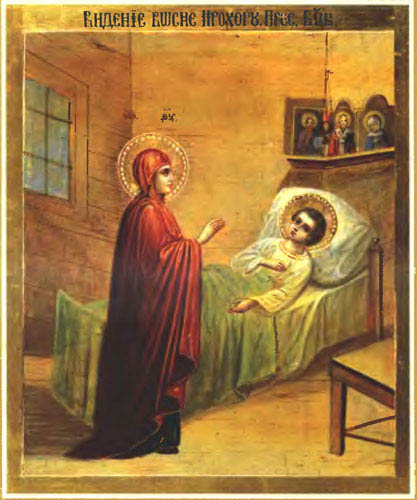
Her promise was soon fulfilled in the following way. A church
procession was winding its way through Kursk. In the procession the
wonder-working Kursk Korenaya (Root) Znamenie (Sign) icon (8 Sep and 27 Nov) was being carried.
When it began to rain heavily, the procession detoured into the yard of St.
Seraphim’s home (either to find shelter for the Icon or to make the way
shorter). Agathia carried St. Seraphim out to meet the Icon and placed him
under the care of the Mother of God; he recovered that same day.
|
|
|
As St. Seraphim grew into a young
man, his mother and his brother Alexei decided that he should start working in
the family mercantile store. Not happy with having to deal with material
concerns, St. Seraphim sought to discern spiritual truths in the day-to-day
events in the life of a tradesman, an approach found in the works of Bishop
Tikhon of Zadonsk (Spiritual Treasures Garnered in the World)—a contemporary of the saint. Like others of
his age, St. Seraphim would spend his free time with friends. However, unlike
most young adults but like many of the Saints, rather than play games and look
for other amusements, they would read the Holy Scriptures and Church Fathers
together.
Seeking a Vocation
The occasion for St. Seraphim receiving a cross at the hand
of his mother, as mentioned above, was her blessing for him to pursue life as a
monastic.
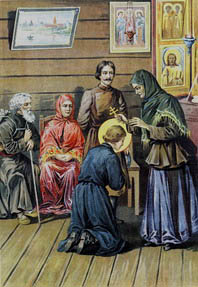 |
 |
However, rather than make such a decision on his own, he—as well five likeminded friends—decided to make a pilgrimage to Kiev (Kyiv), a 450-km journey one-way on foot. Kiev was the cradle of Christianity for the Rusę and home of the Kiev Pechersk Lavra (Kiev Caves Monastery), considered to be the mother house of all Russian monasteries. Furthermore, at the Lavra were to be found the relics of those considered to be the founders of monasticism in Russia: St. Anthony (10 Jul, 28 Sep, and 2nd Sunday of the Great Fast) and St. Theodosius (03 May, 28 Aug, and 2nd Sunday of the Great Fast). (The Saints of the Nearer Caves, or Caves of St. Anthony, are honoured on September 28, the Saints of the Far Caves, or Caves of St. Theodosius, on August 28, and they have a common Feast on the Second Sunday of the Great Fast.)

After worshiping at the Holy Places
and venerating the Holy Relics, the young men all sought guidance for their
life from a startez (spiritual director). They were told they should visit the Elder
Dositheus[20] at the
nearby Kitaev Monastery. On seeing St. Seraphim, the Elder peremptorily blessed
him to go to the Sarov monastery[21]
and gave him this testament:
“Go, child of God, and stay there.
That place will be to thee for salvation, with the Lord’s help. There thou
shalt finish thy earthly pilgrimage. Only try to acquire the unceasing
remembrance of God through the constant invocation of the Name of God thus:
Lord Jesus Christ, Son of God, have mercy on me a sinner! Let all thy attention
and training be in this: walking and sitting, working and standing in Church,
everywhere in every place, coming in and going out let this constant cry be on
thy lips and in thy heart; with it thou shalt find rest, thou shalt obtain
spiritual and bodily purity and the Holy Spirit Who is the source of all
blessings will dwell in thee and will direct thy life in holiness, in all piety
and purity. In Sarov the Superior Pachomius is of God-pleasing life; he is a
follower of our Antony and Theodosius.”[22]
In this way the question of
monasticism and monastery was decided forever for St. Seraphim. Four of the
friends that accompanied St. Seraphim eventually took up the monastic life as
he did (two of them accompanied him to Sarov while the other two chose—or
were assigned to—other monasteries). On returning to Kursk, he took the
next two years to settle his affairs,[23]
yielded up his share of his inheritance in favor of his brother, and set out on
the 560-km trek to Sarov.
Novitiate

Saint Seraphim and his two companions arrived in Sarov[24] on the eve of the Feast of the Entrance of the Most Holy Theotokos into the
Temple, 20 November 1778. The entrance into the monastery—the gates of
the bell tower—were open and the young men were able to proceed to the
Dormition Church and take part in the vigil service. It seems somehow
appropriate that St. Seraphim began his new life in the “temple” by celebrating
the time the Mother of our Lord began her time in the Temple.
The next day the abbot, Father
Pachomius, officially received the three young men into the monastery. In
Prokhor (St. Seraphim) the abbot recognized the soul of a great future ascetic,
and so, for spiritual direction, he committed him to the experienced elder,
Father Joseph, the monastery bursar. Saint Seraphim’s first obedience was as cell
attendant to Father Joseph. In accordance with the general rule (the 4th
c. rule of St. Pachomius), St. Seraphim was given various additional
obediences. He served in the bakery preparing bread and prosphora. He worked in
the furniture shop where he was so proficient that he earned the nickname of
“Prokhor the carpenter.” He performed the task of waking the monks, was church
sacristan, sang on the cliros, and participated in the general obediences of
cutting wood, maintaining the grounds, and such. His solitary devotions and
reading occupied him late at night, allowing himself only four hours of sleep a
day. He not only read, as expected, the Holy Scriptures, standing before the
icons, but he tried to wholly assimilate and practice their meaning. In
addition, he read widely of the Holy Fathers and the Menologion of St. Dmitri of
Rostov. Through it all St. Seraphim distinguished himself by his unmurmuring
obedience, carrying out all of his assignments as best he could both in mind
and might. His devotion, however, did not dampen his youthful cheerfulness,
which made him popular with his fellow novices.

During his second year in the monastery, in 1780, St. Seraphim became ill from
dropsy. His condition continued to deteriorate over the next three years to the
point that he could no longer leave his bed, and the abbot was ready to call
for a doctor. St. Seraphim requested instead that heavenly medicine—the
Eucharist. After that St. Seraphim was quickly restored to health. Later St.
Seraphim related that after the Eucharist had been served, that the Theotokos
appeared to him surrounded by light indescribable, accompanied by the Apostles
Peter and John the Theologian, to whom she turned and said, pointing to
Prokhor, “He is one of our family.” The Mother of God then touched St. Seraphim
on the thigh with her scepter from which water came forth. Until the end of his
life a deep impression remained on his body there.
After he had fully recovered his strength, St. Seraphim sought and received permission from the abbot to leave the monastery in search of contributions to build an infirmary and chapel in thanksgiving of his healing. His travels carried him as far as Kursk, where it is reported that saw his earthly mother again. In 1784, the foundations of the Church of Saints Zosima and Savvas (Zossima and Sabbatius of Solovetz; 17 Apr) were laid, and St. Seraphim himself made the Cyprus-wood altar.

St. Seraphim’s own view of his novitiate is perhaps found in the advice he gave
in later years to young monastics, as captured in the following quotes.
“Whatever the way by which you came into this monastery, do not be discouraged:
God is here. Monastic life is not easy. Do not consider giving up one monastery
for another at your first disappointment. A novice must will to persevere. From
the hour he enters the monastery to the day of his death the life of a monk is
but a terrible struggle against the world, the flesh, and the devil.”
[25]
“Obedience is the foremost virtue, before fasting and praying.” “If you have
handiwork, work on it alone. If you are in your cell without any handiwork,
engage in some reading, in particular the Psalter.” “Those who have truly
decided to serve the Lord God should exercise themselves in remembrance of God
and the ceaseless prayer to Jesus Christ. In handicrafts, or anywhere on
obedience, ceaselessly repeat the prayer, ‘Lord Jesus Christ, have mercy on me,
a sinner.’ Be heedful in prayer, that is, collect your mind and unite it with
your soul. At first one day, then two, increasing, then saying the prayer with
the mind alone, attentive to every separate word. When God warms your heart
into one spirit, the prayer will flow in you without end, and will always be
with you, delighting and nourishing you. … When this spiritual food is
constantly within you—that is, discourse with the Lord Himself—then
why go visiting the brothers’ cells, even should they invite you? Truly, I tell
you that idle talk is love of idleness.” During fasts “take food once a day,
and an angel of God will cling to you.” “Acquire peace and thousands around you
shall be saved. If it is impossible not to become disturbed, then at least try
to hold your tongue, according to the Psalmist, ‘I was troubled and spake not.’
In order to escape judgment, you should be attentive to yourself and ask ‘where
am I?’” “You should throw off despondency, and strive to have a joyful spirit,
not a sorrowful one, in the word of Sirach, ‘Sorrow destroys much, and there is
no use for it.’ This sickness is healed by prayer, restraint from idle talk,
handiwork as you are able, reading the Word of God and patience; because
despondency arises from illness.”
[26]
“We have no reason to be sad, for Christ has conquered all. He has bestowed
life upon Adam, freed Eve, and killed death.”
[27]
Tonsure

Eight years after his arrival at the monastery, 13 August 1786, the
twenty-seven year old Prokhor was tonsured by Fathers Joseph and Isaiah. Abbot
Pachomius, impressed with the young man’s ardent, “seraphic” (flaming) faith,
gave him the name of Seraphim. After having been received into the ranks equal
to that of the angels, St. Seraphim increased his podvig—ascetic
struggles—with a focus on silence. “More than anything else one should
adorn oneself with silence; for St. Ambrose of Milan says: I have seen many
being saved by silence, but not one by talkativeness. And again one of the
Fathers says that silence is the mystery of the future age, while words are the
implement of this world (St. Isaac the Syrian). Only sit in your cell in
heedfulness and silence, and by every means strive to draw near to the Lord,
and the Lord is ready to transform you from a man into an angel, and to whom, He says, will I look, but to him that is
meek and silent, and that trembleth at My words? (Is. 66:2). When we remain in silence, our enemy the devil will have
no success with regard to a man with a hidden heart; by this, however, must be
understood silence in the mind.”[28]
Diaconate
On 27 October 1786,[30]
St. Seraphim was ordained to the Diaconate by Bishop Victor of Vladimir. While
the mere fact of St. Seraphim’s promotion was evidence of the esteem with which
he was held by Abbot Pachomius, his regular service at the altar was perhaps
more so. Saint Seraphim had this to say: “Our Fathers of blessed memory, the
Abbot Pachomius and the treasurer Isaiah, both saintly men, loved me as their
own souls. And they hid nothing from me; and they cared for the things which
were profitable for their souls and for myself. [And] when Pachomius served
[both in and without the monastery], he rarely did so without me, poor
Seraphim.”[31] In
preparation for service, St. Seraphim would spend whole nights in prayer; after
the service, he would faithfully remain behind, meticulously caring for the
vessels, vestments, and general order of the sanctuary. The importance of these
duties were expressed by St. Seraphim in various ways. “Even the dust of the
Temple of God is sacred. There is no higher obedience than a Church obedience!
And were it only to wipe the floor of the house of the Lord with a cloth, this
will be counted higher than any other action by God! And all that is done
there, and how you go in and out, all ought to be performed with fear and
trembling and with unceasing prayer.”[32]
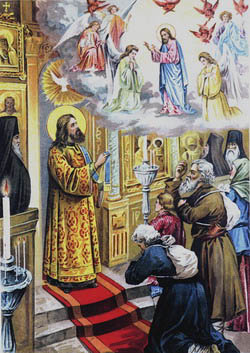
Saint Seraphim’s faithfulness in such matters are, perhaps, best expressed by the
graces he received during this period: he was privileged to see angels
ministering at the altar and heard their singing. He said “nothing can be
compared to this heavenly music. In my bliss which nothing could disturb I
would forget everything. I wasn’t conscious of being on earth; I only
remembered coming into church and leaving it… but the time spent at the altar
of the Lord was wholly light and splendor. My heart melted like wax in the heat
of that ineffable joy. One Holy Thursday, I celebrated with Father Pachomius.
Before the ‘Entrance’ with the Gospel, while the priest in the sanctuary was
uttering the words: ‘Grant that the holy angels may enter with our entrance to
minister with us and to glorify thy goodness,’ and while I was standing before
the Royal Doors, I was suddenly dazzled as though by a sunbeam and, as I
glanced towards that Light, I saw our Lord Jesus Christ in his aspect of Son of
man, appearing in dazzling glory surrounded by the heavenly hosts, the seraphim
and cherubim! He was walking through the air, coming from the west door towards
the middle of the church. He stopped before the sanctuary, raised his arms and
blessed the celebrants and people. Then, transfigured, he went into his icon by
the Royal Door, still surrounded by the angelic escort which continued to
illumine the church with its shining light. As for me, who am only dust and
ashes, I was given the grace of receiving an individual blessing from the Lord
so that my heart overflowed with joy.” For those who witnessed the scene, St.
Seraphim’s expression suddenly changed, and he became rooted to the spot. Two of
the other deacons took him by the arms and brought him into the sanctuary where
he remained for two hours without being able to utter a word.
[33]
During St. Seraphim’s diaconate, another event took place that would eventually prove to be momentous for his future ministry. Starez Joseph died and Abbot Pachomius decided that he would take over as spiritual guide to St. Seraphim. As a result, during his pastoral visits to the surrounding communities, Father Pachomius would often take St. Seraphim with him. Thus it was when in June 1789, St. Seraphim met Mother Alexandra (Agathia Semenovna Melgounova) in Diveyevo.
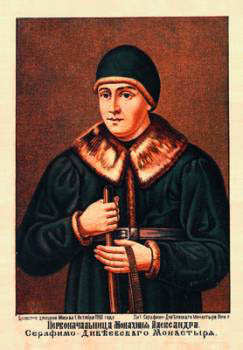
She had gathered several women and girls around her who wanted to
live a life of prayer; and it was from what would turn out to be her death bed
that month that she extracted a promise from the abbot not to forsake her
little community. Father Pachomius answered prophetically: “Mother! I do not
refuse to serve the Heavenly Queen according to my strength and your
commandment. But how to undertake it, I do not know. Shall I live to that day?
But here is Hierodeacon Seraphim. His spirituality is known to you, and he is
young. He will live to that day. Entrust him with this great task. Mother
Alexandra answered that while she was only making a request, “the Heavenly
Queen would then instruct him herself.”
[34]
Priesthood
After being recommended for the honor by Abbot Pachomius, on
02 September 1793, St. Seraphim was ordained priest by Bishop Theophilus of
Tambov (to which diocese the monastery had recently been transferred). In this
capacity St. Seraphim served with great fervor, celebrating daily, which for
him was “A well of water springing up into everlasting life.”[35]
The importance of Eucharist to the saint is, perhaps, captured in the following
instruction he gave to the sisters of Diveyevo: “It is not right to forego the
chance to benefit as often as possible from the blessing given through the
Communion of the Holy Mysteries of Christ. Concentrate as hard as you are able,
in meek awareness of your utter sinfulness and with hope and firm faith in
God’s unspeakable mercy, upon approaching His Holy Mysteries by which He has
redeemed all and everyone. Say with tender feeling, ‘Forgive me my sins, O
Lord, that I have committed with my soul, heart, words, deeds, and all my
senses.’[36]
There can also be no doubt that the Grace bestowed by Christ through the
Apostles and down to the Priesthood St. Seraphim received by the laying on of
hands was reflected in his ministry.
Hermit
Abbot Pachomius died on 06 November 1794, and so St.
Seraphim lost another staretz. St. Seraphim said “Joseph [his first staretz]
and Pachomius were two pillars of fire with their flames leaping up to heaven.”[37]
The Elder Isaiah became his new staretz, and also took over as abbot of the
monastery. The death of Pachomius was to be a mile marker or turning point in
St. Seraphim’s life, for in just two weeks he was to leave the enclosure of the
monastery to live as a hermit in the dense woods that surrounded Sarov. From
the available biographical material, it is not clear just what the underlying
motivation was. It has been variously suggested that St. Seraphim’s desire was
because he was a “‘heavenly man’ [who] flew away to solitude ‘for God’s sake’,”[38]
because he “bitterly lamented”[39]
the loss of Pachomius, because he desired to move “deep into the desert,”[40]
because he “felt free to request permission to withdraw to a deserted part of
the forest”[41] (as if he
had been longing to do this for some time but was unwilling to leave
Pachomius), or it was because he had lost “the spiritual help which he still
needed” and “was earnestly seeking for prayer and the increasing pilgrimages to
the monastery were a hindrance to the life of silence which he loved.”[42]
It has also been suggested that he wanted to separate himself from strife
within the monastery.[43]
This last interpretation comes from advice given later by St. Seraphim to a
monk who had asked: “‘Father… people say that retirement from a community into
solitude is pharisaism and that such a change of life means disparagement of
the brethren or else their condemnation.’ To this Father Seraphim replied: ‘It
is not our business to condemn others. And we leave the Brotherhood not out of
hatred for them, but chiefly because we have accepted and wear the habit of Angels,
for whom it is unbearable to be where the Lord God is offended by word and
deed. And therefore when we separate ourselves from the Brotherhood, we only
avoid hearing and seeing what is repugnant to God’s commandments which may
happen in a multitude of brethren. We do not run away from men who are of the
same nature as we are and who bear the name of Christ, but from the sins which
they commit. As it was said to the Great Arsenius: ‘Flee from men, and thou
wilt be saved.’’”[44] The
apparent motivation was due to St. Seraphim’s poor health, for the note giving
him permission to leave read “…on account of his unfitness for life in
community, owing to his illness… .”[45]
However, St. Seraphim was very far from willful; it is better stated that the
true motivations were spiritual, and for him to make the radical shift from
life as a cenobite to that of an eremite could have only come as an
obedience—as formerly to his mother, Elder Dositheus, Elder Joseph, and
Abbot Pachomius—to his new spiritual father, Abbot Isaiah, as he, in
turn, would have been obedient to the guidance of the Holy Spirit. It should
also be noted that, in the physical realm, this was apparently somewhat “risky”
for Father Isaiah, as hermitages and sketes had been banned under Peter the
so-called “Great,” a ban that would not be lifted until 1822. (Nor was St.
Seraphim the only hermit permitted to live in the woods around Sarov.)
Thus it came about that on 20
November 1794, sixteen years to the day after he had first passed in through
the gates of the Sarov “Desert” bell tower, St. Seraphim passed through the
gates into a deeper “desert” and the life of a solitary. The monastery’s
“summer house” (later known as the far hermitage) into which he settled was
located some five versts (5.3 km or 3.3 miles) away along the Sarovka River.
The hermitage was a small, one-room log cabin with a porch, anteroom, and
celler. It was furnished only with stove, a wooden chopping block which served
as a chair and table, and a sack of stones for a bed.
|
|
|
In the corner opposite the stove, St. Seraphim hung an “Umilienie” icon [46] of the Theotokos—an icon he was to keep with him throughout his life (he died before it while kneeling in prayer)—and to who he dedicated the hermitage. Outside of the cabin St. Seraphim maintained a vegetable garden which, other than bread from the monastery, provided all his food. He named his new home “Mount Athos” and gave Biblical names to the surroundings.

In hermitage, St. Seraphim’s life
consisted chiefly of prayer. He usually said the Divine Office in the customary
order. He arose about midnight and recited the Midnight Service, the Orthros,
and read the First Hour. Before ten in the morning he began his reading of the
Third, Sixth, and Ninth Hours, and the Typical Psalms. The afternoon was
followed by recitation of Vespers, and after his evening meal, the Prayers
after Supper (Compline). Before retiring he said the Prayers before Sleep. St.
Seraphim also intoned the Psalms appointed by the Rule of St. Pachomius, and
read the Scriptures—especially the Gospels. “Holy writings,” he said
later, “should be read in order to free the soul to rise to the heavenly realms
and partake of the sweetest discourse with the Lord.”[47]
At all other times he continuously repeated the hesychast silent Prayer of the
Heart.[48]
His daily work consisted of tasks such as gathering moss for fertilizer and
tending his garden, chopping wood, and strengthening the banks of the river.
Later he began to carry a heavy sack filled with earth and stones, and in which
lay the Holy Gospel; St. Seraphim said that he did this, using the words of St.
Ephrem the Syrian, in order to “oppress him who oppressed me.”[49]

While he was generally separated from people during his stay in the
hermitage—only occasionally receiving visitors such as other nearby
hermits—the animals of the forest became his friends. Father Joseph
related, as an eye-witness, that rabbits, foxes, lynx, lizards, bears, and even
wolves would gather at midnight at the door of the cabin and wait for St.
Seraphim to finish his prayers and come out to feed them with bread. It has
also been related by several people that a bear would take bread from his
hands, as well as obey his orders by, for example, fetching honey when there
was a visitor.

On Saturdays and on the eve of feast days, St. Seraphim would walk to the
monastery to take part in corporate worship, including Vespers, Orthros, and
Divine Liturgy. (Although he always wore his vestments when he partook of the
Eucharist, he no longer celebrated, considering himself unworthy.) He also
spent the first week of the Great Fast at the monastery, joining his fellow
monks in prayer and in abstaining from all food. After Communion on Sundays he
would remain in the monastery until evening, receiving those who came to visit
seeking advice or consolation. He would then return to his hermitage, bringing
bread for the week.
On 09 September 1804, three men in search of money or other valuables attacked St. Seraphim. In their rage of not finding anything worthwhile, they beat him severely and left him for dead. While he could have defended himself—he was carrying an axe and was known at the time to have been a powerful man—he did not resist.
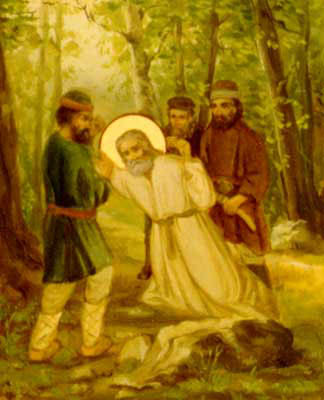
Over the
course of the next day he managed to drag himself to the monastery, suffering
from multiple injuries to his head, chest, ribs, and back. While doctors were
called for, St. Seraphim refused treatment, and fell into a semi-coma. At some
point he had another vision of the Theotokos, accompanied by the Apostles Peter
and John. “What is the use of doctors?” she said. “He is of our family.” Eight
days after the attack and a few hours after this vision, he was able to get up,
walk a little, and take some nourishment. But only after five months had passed
was St. Seraphim able to return to his hermitage (ca. February 1804), although
physically he was to remain crippled and bent over throughout the rest of his
life (as often seen in icons of the saint), which was taken as a sign of his
humility.
[50]
What can be said of this attack?
The devil, in his inability to conquer the saint through the spiritual attacks
and temptations that faced him in the preceding years, tried to overcome him in
the physical realm. When St. Seraphim was asked if he had seen demons, he was
silent and then simply said “they are despicable.” At another time St. Seraphim
related that “He who has chosen the hermit life must feel himself constantly
crucified… The hermit, tempted by the spirit of darkness, is like dead leaves
chased by the wind, like clouds driven by the storm; the demon of the desert
bears down on the hermit at about mid-day and sows restless worries in him,
distressing desires as well. These temptations can only be overcome by prayer.”[51]

In apparent response to the physical attack, however, at some point during the
year after his return to the hermitage (ca. March 1804 to March 1805), St.
Seraphim undertook what was to become his most challenging podvig: although it
was only to become known at the end of his life, he chose to undertake a
stylite-like contest, even as crippled as he was, by spending one-thousand days
and nights in prayer on a granite rock (some say 1001), only interrupting the
task for necessary care of the body (rest and food[52]);
by night he prayed on a bolder located in the forest about halfway between his
cell and the monastery, and by day on another stone that he had dragged into
his cell so as not to be seen by people. When this feat was revealed at the end
of the saint’s life, one of the brethren said in astonishment: “This is above
human strength.” St. Seraphim replied: “St. Simeon the Stylite stood for
forty-seven years on a pillar. Are my labors comparable to this?” The brother
responded that he must have been helped by grace. St. Seraphim agreed saying,
“Yes, otherwise human strength would not have been sufficient. When there is
contrition in the heart, then God is also with us.”[53]
St. Seraphim completed his work as a “stylite” at some point not too long
before Abbot Isaiah died on 04 December 1807.[54]
St. Seraphim next undertook another ascetical work: that of silence. He
remained completely cutoff from the world except for the weekly visit of a monk
who began to bring him some bread and boiled cabbage.
[55]
This mode of life in the hermitage continued until the new abbot, Niphont,
decided he would not continue to support St. Seraphim in his isolation, but
rather demanded that he resume attending services on Sundays and feast days, or
else return to the monastery. So it was that on 08 May 1810 St. Seraphim
returned from the hermitage to the monastery. However, he continued his
practice of silence and shut himself up, with permission, in his cell, only
coming out at night for short walks, and he received no visitors. Holy
Communion and food was brought to him in his cell, which he received on his
knees with his face covered with a piece of linen. The furnishings of his cell were not unlike those of the
hermitage, except for the addition of a coffin that the saint had made for
himself. As before, St. Seraphim continued to occupy himself with internal
(hesychast or Jesus) prayer and reading. To his silence he also added the
additional podvig of wearing a heavy iron cross. He was not alone, however; the
Theotokos was always present through her icon, and angels began to appear and
converse with him.
Ca. 1813 St. Seraphim began to relax his reclusion by occasionally receiving some people whom he would hear and instruct; for example, on 13 September that year the Tambov Governor A.M. Bezobrazov and his wife came, and the Elder opened his door to them himself and silently blessed them. In 1815, St. Seraphim brought an end to his isolation; monks could now enter his cell to visit, and on occasion he would receive other visitors (although, in general, he continued to practice silence); he was even visited in 1825 by Tsar Alexander I.[56]
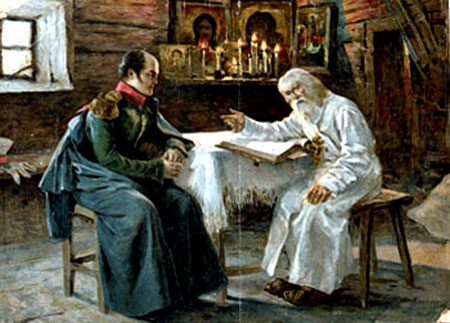
Finally, on 25 November 1825, the Theotokos again appeared to St. Seraphim in a
vision, accompanied by St. Onuphrius the Great and St. Peter of Athos (both 12 June), and told him he was now
ready to devote himself in ministering to others.
Spiritual Father
While the Sarov Monastery was, for years, a place of
pilgrimage, news concerning the man-of-God Seraphim had spread far and wide.
People began to flow to Seraphim-as-staretz in such numbers that it disturbed
the operation of the monastery. Pilgrims rushed the gates in the morning, and
it was often impossible to shut them before midnight. As a partial relief St.
Seraphim received the blessing of the abbot to divide his time between life in
the forest and at the monastery.[57]
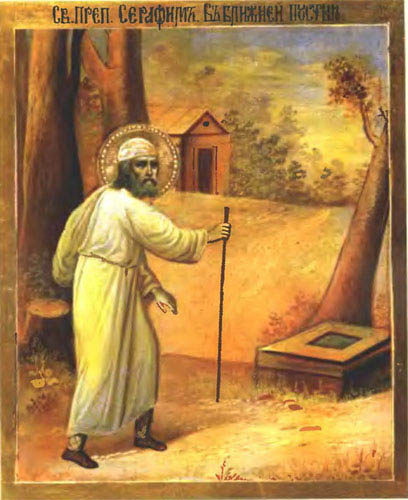
On his first day of “freedom” he had traveled about 1½ miles along the
Sarovka toward his original (far or distant) hermitage when the All-Holy
Theotokos appeared to him, accompanied by the Apostles Peter and John. She
beckoned to St. Seraphim, struck the ground with her staff, and a fountain of
water gushed forth from an old, long since dried up spring. The water, she told
him, had the power of healing, and she placed the spring under his care. Close
by the spring, the monks built St. Seraphim a new hut that he would call his
near hermitage.
To all who came to him he would bow
to the ground and address with the salutation “Greetings, my joy, Christ is
risen.” He would also offer them a piece of antidoron (blessed bread) dipped in
wine. St. Seraphim counseled in practical and spiritual matters, frequently
anticipating the needs and requests of suppliants. When asked about this
ability, St. Seraphim explained “They come to me and see in me a servant of
God; and I, lowly Seraphim, consider myself as His humble servant, and what God
orders His servant I transmit. I consider the first thought that comes to my
mind as sent by God. What I say is spoken without my knowing what goes on in
the heart of the person I am talking to, but in the belief that it is God’s
will and that it is for his good.”[58]
Prophet
By the very nature of his role as a staretz, the Holy Spirit
worked through St. Seraphim to guide the faithful, and this often took the form
of prophetic utterances. Many are found recorded in the various biographies of
the saint. A few selections follow.
To a Father Anthony: "You will be leaving your monastery, but you are not to die yet. Instead, you will be appointed to head a large and famous monastery elsewhere." Sometime later he was indeed appointed to serve as acting head of the Monastery of the Holy Trinity-St. Sergius in Zagorsk.[59]
Regarding the Diveyevo convent:
"I entrust you to God and to our All-Holy Virgin. Have no fear. After many
trials, order will be restored to the convent with the twelfth Mother Superior,
whose name will be Mary." (see Diveyevo discussion below.) Such troubles
began during Seraphim's lifetime due to jealousy, pettiness, and intrigue on
the part of some of the fathers.[60]
It is also related that before St. Seraphim reposed, he had given a candle to
his spiritual son, N.A. Motovilov, and told him, “When my relics return to
Diveyevo, meet me with this candle.” Motovilov said in astonishment,
“Batiushka, the monks of Sarov will never give you to Diveyevo.” St. Seraphim
simply repeated that it would be so. After Motovilov’s death the candle was
passed from nun to nun until Matushka Margarita returned to the village from
prison, when it was passed on to her. When St. Seraphim’s relics arrived in
1991, having been carried for miles on the shoulders of eager pilgrims,
Matushka Margarita met her beloved elder at the gate with the lighted candle.
St. Seraphim not only predicted the monastery’s closing, but its revival as
well. Matushka Margarita says, “He said that the churches would be destroyed
for seventy years and then given back, ‘without your asking.’ But I am still
awaiting the arrival of the great Diveyevo bell that was taken away after the
monastery closed. St. Seraphim said that after the reopening of the monastery
the great bell will return overland, and at its ringing, he and the four
others, whose relics he will uncover, will arise. Soon afterwards the end will
come.”[61]
Regarding apostasy in Russia: “At
that time Russian bishops will become so ungodly that their impiety will exceed
that of the Greek bishops who lived in the reign of Theodosius the Younger.
They will not even believe in the most important dogma of the Christian Faith
the Resurrection of Christ and the general resurrection.”[62]
Regarding the fall of Russia (as
related by Countess Natalia Vladimirovna Ursova): "I knew of the prophecy
of St. Seraphim about the fall and resurrection of Russia; I knew it
personally. … Count [Y.A.] Olsufyev… once brought me a letter to read through,
with the words: 'I have preserved this as the apple of my eye.' The letter,
yellow with age, with severely faded ink, had been written by the very hand of
the holy St. Seraphim of Sarov to Motovilov. In the letter was a prophecy
concerning those horrors and misfortunes which would befall Russia, and I only
remember what was said in it about both the pardon and salvation of Russia.
…"[63]
After his repose, St. Seraphim also appeared in a prophetic vision to St. John
of Kronstadt regarding the persecutions that Christians were to undergo in
Russia.[64]
Regarding Tsar Nicholas II: St.
Seraphim of Sarov prophesied in clear words about the tragic fate foreordained
by God for the Tsar who would be present at the Savor solemnity of faith, when
there would be Pascha in the midst of summer (the glorification and
canonization of St. Seraphim in 1903). According to his prophecy, if there
would be repentance in the Russian people, God would yet have mercy on her, but
first He would allow for a time the triumph of lawless men: the Tsar would to
overthrown and killed, so that the people might know in experience what life
was like under the Tsar anointed by God, and under the rule of men who have
trampled underfoot the law of God. St. Seraphim, by revelation from God, wrote
in his own hand a letter to the Tsar who would come to Sarov and Diveyevo, entrusting
it to his friend Motovilov, who gave it to Abbess Maria, who in turn handed it
personally to Emperor Nicholas II in Diveyevo on July 20, 1903. What was
written in the letter remains a secret, but one can suppose that the holy elder
saw all that was to happen and warned against the frightful events to come... [65]
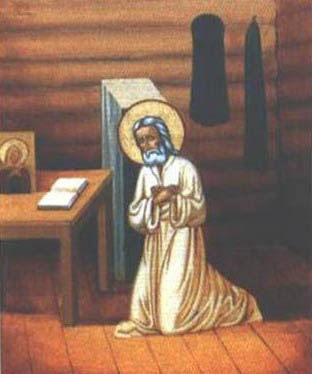
Regarding his own death, St. Seraphim said that a fire would alert the monks
about it. On Sunday, January 1st, 1833, the Starets came to church, partook of
the Holy Eucharist, and bade farewell and consoled to his fellow monks and
novices saying "Do not be dejected, be alert, the present day prepares a
crown." Three times that day he was observed to leave his cell and
meditate over the location where he had requested to be buried. He was also
heard to be intoning Easter--and not the expected Christmas--hymns. About six
o'clock the following morning, monks noticed smoke coming from under his door.
When he did not answer, they entered his cell and found a smoldering fire that
had started from a candle that had fallen from his hand after he died while
kneeling in prayer.[66]
Healer
St. Seraphim is known as a wonderworker through who God
worked many miracles of all kinds. And he still continues to work miracles,
even beyond the borders of his native land. The miracles associated with St.
Seraphim are so numerous they are far beyond recording here (for which see some
of his many biographies), and God alone knows of all those unrecorded. However,
as an illustration, two healings are presented here for God’s Glory.

In 1822, before St. Seraphim had completely ended his reclusion, Michael
Vasileevich Manturov came to see him in the hope that God would help where
doctors could not. Michael Vasileevich had served in the Russian military in
Lithuania for many years. While there he had contracted some form of wasting
disease in his legs, and was eventually forced to resign and return to his home
that lay ~25 miles (40 km) from Sarov. However, the best of medical help was
unable to discern what was wrong, let alone provide a cure.

When the disease progressed to the point that pieces of bone dropped from his
legs he became determined to see St. Seraphim. He was carried by his serfs to
the cell of the then reclusive saint. After Michael Vasileevich made the customary
prayer, St. Seraphim came out and kindly asked “what brings you to see poor
Seraphim?” Manturov fell at his feet and begged the Elder to heal him. St.
Seraphim asked him three times, “Do Vasileevich responded each time with a
strong, positive affirmative. St. Seraphim said to him “My joy, if you so
believe, then believe also that to the faithful everything is possible to God;
and so believe that God will also heal you, and I, poor Seraphim, shall pray.”[67]
The saint then took some oil from the lamp burning in front of the Icon of the
Virgin in his cell and anointed Manturov’s legs, wrapped them in pieces of
canvas, and said “By the grace given me from the Lord, you are the first whom I
heal.” St. Seraphim then stuffed handfuls of blessed bread into Manturov’s
pockets and told him to return to the monastery guest house. The invalid, who
normally could hardly stand, began to carry out this order, then realizing that
he was walking without help, returned to the saint and fell at his feet in
thanksgiving. St. Seraphim picked him up and said “Is this healing Seraphim’s
doing? No, no, my joy, only God does this, and you owe your cure to Him and his
holy Mother.”[68] Later, in
thanksgiving, Manturov was to sell his lands, free his serfs, move to Diveyevo,
and there serve St. Seraphim until 1831 as an intermediary with the sisters.

On the 9th of September, 1831, Nicholas Alexandrovich
Motovilov—a man also destined to help Diveyevo—was laid at the feet
of St. Seraphim. “One year before he commanded me to serve the Mother of God in
Diveyevo Convent, the great Elder Seraphim healed me from serious and
extraordinary rheumatic and other illnesses, a weakening of the entire body and
the loss of the use of my legs, which were contorted, and swollen knees, with
sores upon the sides and back. From such a disease did I suffer incurably for
more than three years. In 1831, on the ninth of September, Fr. Seraphim healed
me of all my diseases with only one word. The healing occurred in this way. At
my request for help and healing, he said, ‘I am not a doctor; you must go to a
doctor to be cured of any kind of illness.’ I gave him a detailed account of
all my calamities, about the three major medical methods I had tried… But by
none of thee methods was I cured of my diseases, and so I realized that I could
not be healed of my ailments by any means save the grace of God. But being a
sinner and not having boldness before the Lord God, I asked for his [St.
Seraphim’s] holy prayers, that God would heal me. He then asked me a question,
‘Do you believe in the Lord Jesus Christ, the He is God incarnate, and in the
Most Pure Mother of God, that she is the Immaculate Virgin[69]?’
I answered, ‘I believe.’ ‘And do you believe,’ he continued to ask me, ‘that
the Lord instantly healed with one word, or with His touch, all such diseases
as the people had, and so can even now, just as easily and instantly as before,
heal all who ask His help, with His same one word, and that an entreaty to Him
by the Mother of God for us is all-powerful, and that by her entreaties the
Lord Jesus Christ can even now, this instant, heal you completely?’ I answered,
‘I trust with all my heart and believe it, and if I did not believe it, then I
would not have asked them to bring me to you.’ ‘If you believe,’ he concluded,
‘then you are healed already.’ ‘How can I be healed,’ I asked, ‘when my people
and you yourself hold me in your arms?’ ‘No,’ he said to me, ‘your entire body
is perfectly healthy at last.’ He ordered those who were holding me in their
arms to step away… I felt within me some kind of power descending upon me from
on high, I lightened up a little and walked… Then he talked with me a good deal
more, and sent me off to the guest house completely restored. And so, my people
left without me… thanking God for His wondrous mercy shown to me before their
very eyes. …”[70]
Director
In 1780, in the small village of
Diveyevo[71]
that is located about 12 km (7 mi) NNW of Sarov, a wealthy widow by the name
Agathia Semenovna Melgounova (or Agatha Melgunova)—later Mother
Alexandra—built a church and received permission to set up a women’s
community. On her death bed in 1789, as previously related, she asked Abbot Pachomius
not to forsake her little community, and who, in return, offered up St.
Seraphim as one suitable to be so entrusted. It was not until 1823, however,
that St. Seraphim took a visibly active role in the community. In that year he
asked Michael Manturov (who had been healed the previous year) to stake out
some land near the church that Mother Alexandra had built. A year later a new
community was formed there; it differed from the adjacent convent formed by
Mother Alexandra in that only virgins (i.e., no widows) were allowed there. The
Theotokos was considered to be their Abbess. A church was built for the convent
by Manturov in 1829 and consecrated on the Feast of the Transfiguration (06
August). St. Seraphim gave the sisters a simple rule involving obedience,
prayer, and regular attendance at the Divine Liturgy. Since the sisters worked
in the fields and in operating a mill, he discouraged undue fasting.
St. Seraphim also provided for the
sisters spiritual and material welfare. Although he never personally visited
the convent, the sisters would visit St. Seraphim at the Sarov monastery or in
one of the hermitages; on such visits they would receive the spiritual guidance
required as well as bags of provisions. At times, these visits became
opportunities to witness various wonders or miracles; for example, Sister
Eupraxia (Eudoxia Ephraimovna) was to share in the twelfth (and last) visit of
the Theotokos to St. Seraphim. This occurred on the eve of the Feast of the
Annunciation (24 March) in 1831. After having prayed through the night, a sound
was heard at dawn like a wind rising in the forest, which turned into singing
as it grew closer. St. Seraphim told Eupraxia, “Do not be afraid. Behold the
Lord’s grace coming down to us.” The air became scented as the richest incense.
St. Seraphim raised his arms and then fell prostrate crying out “O, most holy
Theotokos!” Eupraxia then saw two angels enter, preceding the entrance of the
Queen of Heaven. Accompanying the Theotokos were the Apostles John and Peter,
and with them twelve virgin-martyrs, each with a crown. The cell was lit with
such a brilliant light that Eupraxia was dazed and fainted. The Theotokos,
herself, raised Eupraxia up, and presented her to the holy martyrs. Eupraxia
also recalled hearing the Theotokos tell St. Seraphim “Soon, my dear one, you
shall be with us.” The vision lasted four hours![72]
After St. Seraphim died, his
spiritual presence continued to be felt in Diveyevo, and in all their
difficulties they turned to him for spiritual help. Every evening the sisters
would gather around a candle and recount some detail of the Staretz’ life, and
the saint seemed to join their circle and fill their hearts with comfort and
joy. On a few occasions, St. Seraphim actually appeared to some of the sisters.
For example, on New Year’s Eve 1835, one of the sisters went to the church to
pray and saw St. Seraphim dressed in white vestments coming to meet her. “Is it
you, Little Father?” she asked. “Of course it is, my joy. Don’t you recognize
me? Yet you go on calling me. O how unbelieving you are. Don’t you realize by
now that I’m celebrating with you in the church every day?” The saint then
returned to the sanctuary through the Beautiful Gate.[73]
However, although the Theotokos and
St. Seraphim continued to spiritually watch over the community, the troubles
that the saint had prophesied about came to pass. A certain Ivan Tikhonovitch portrayed
himself (falsely) as a disciple of St. Seraphim, and was able to gain influence
and control of the Diveyevo communities. In 1842 he was able to obtain
permission to amalgamate the communities (thc one started by Mother Alexander
with the “mill” community or “orphans” of St. Seraphim). He then built a new
church according to his taste, closed those of St. Seraphim, and replaced most
of the other structures as well. By 1848 Ivan decided to build a cathedral at
Diveyevo, although not according to St. Seraphim’s design or location, but
following after his own thoughts. However, when Archbishop Jacob of
Nijni-Novgorod came to bless the work on 14 June 1848, Michael Manturov was
able to lay before him all of St. Seraphim’s plans. The archbishop, thoroughly
upset, went to the site where Ivan had begun digging the foundations,
and—like the Old Testament Balaam who had blessed Israel instead of
cursing her—he spoke blessings on the plans of St. Seraphim and not those
of Ivan: “May the Lord bless this foundation on the spot which Father Seraphim
foresaw and which Michael Manturov has shown me.”[74]
In 1858, after Manturov died, Ivan (now known as Father Joseph), thinking
himself free from all rivalry, began anew to machinate concerning Diveyevo.
When it was announced in 1861 that the community had been promoted to the rank
of monastery, Father Joseph worked through his friend, Archbishop Nectary of
Nijini-Novgorod to depose the then duly elected (by the sisters) superior
Elizabeth as being unworthy, and set up sister Glykeria—who was loyal to
Joseph—in her place. With Manturov gone, Nicholas Motovilov—the
very one who, like Manturov, had been healed through the prayers of the
saint—now took up “arms” to protect Seraphim’s “orphans”. Motovilov
brought the affair to the attention of Metropolitan Philaret through the agency
of Archimandrite Anthony, Abbot of the Monastery of the Holy Trinity-St.
Sergius in Zagorsk (as St. Seraphim had prophesied). Metropolitan Philaret, in
turn, briefed Tsar Alexander II concerning the situation in Diveyevo, who then
launched a full investigation. The end result was that the community of
Diveyevo was placed under the jurisdiction of the Archbishop of Tambov,
Archbishop Nectary was transferred, Joseph was forbidden to set foot in the community
again, Joseph’s supporters were sent away, and sister Elizabeth took the great
habit under the name Mary and was installed as the twelfth
superior—fulfilling another prophecy of St. Seraphim.
Teachings

Although it can be stated that St. Seraphim was certainly literate, he did not write any theological treatises or spiritual works. What teachings of the saint we have were principally recorded by the monks of Sarov, and in particular Hieromonk Gury. [75] Circa 1837 the first biography of St. Seraphim was compiled by Hieromonk Serge (Sergius) of the Monastery of the Holy Trinity-St. Sergius in Zagorsk (presumably by the direction of Archimandrite Anthony). As a supplement to this Life, Serge included 33 counsels or instructions of the saint; these were eventually edited by Metropolitan Philaret and published in an appendix to Father Serge’s Short Sketch of the Life of Starets Mark, Monk and Hermit of the Monastery of Sarov. A expanded collection of 43 instructions was published as part of Leonid Denissov’s work Zhitie prepodobnavo ottsa nashevo Seraphima Sarovskavo in 1904. Selections and digests of these instructions can be found in most biographies of the saint. The complete set is available in English in Volume One of the Little Russian Philokalia. [76] These instructions give indisputable evidence of St. Seraphim’s knowledge of the Philokalia and the whole Hesychast tradition, as well as a deeply personal life with Christ in the Holy Spirit.
But perhaps the most important
thing we have from the saint is known by various titles such as “a conversation
with the saint” and “on the acquisition of the Holy Spirit;” this, too, appears
in most biographies of the saint. This conversation took place with Nicholas
Motovilov in November 1831. “… when you were a child… They instructed you to go
to church, to pray, to do good works, telling you that there lay the goal of
the Christian life. … Prayer, fasting, works of mercy—all this is very
good, but it represents only the means, not the end of the Christian life. The
true end is the acquisition of the Holy Spirit. … You know what it means to
earn money, don’t you? Well, it is the same with the Holy Spirit. The aim of
some men is to grow rich, to receive honors and distinctions. The Holy Spirit
himself is also capital, but eternal capital. Our Lord compares our life to
trading and the works of this life to buying: ‘Buy from me gold…that you may be
rich’ (Rev. 3:18). … The only valuables on earth are good works done for
Christ: these win us the grace of the Holy Spirit. No good works can bring us
the fruits of the Holy Spirit unless they are done for love of Christ. That is
why the Lord himself said, ‘He who does not gather with me, scatters’ (Matt.
12:30). In the parable of the virgins, it was said to the foolish virgins when
they had no oil: ‘Go to the dealers and buy’ (Matt. 25:1-12). … What…could be
termed lacking when…they had preserved their virginity…one of the greatest
virtues… I dare to think that what they were lacking was the grace of the Holy
Spirit. For the essential thing is not just to do good but to acquire the Holy
Spirit as the one eternal treasure which will never pass away. … Among works
done for the love of Christ, prayer is the one that most readily obtains the
grace of the Holy Spirit, because…it is within reach of all men…” Toward the
middle of this conversation, both St. Seraphim and Motovilov became illumined,
much as Moses of the Old Testament after he came down from Mount Sinai (Ex.
34:29-35). Motovilov related: “Then I looked at the Staretz and was panic-stricken.
Picture, in the sun’s orb, in the most dazzling brightness of its noon-day
shining, the face of a man who is talking to you. You see his lips moving, the
expression in his eyes, you hear his voice, you feel his arms round your
shoulders, and yet you see neither his arms, nor his body, nor his face, you
lose all sense of your self, you can see only the blinding light which spreads
everywhere, lighting up the layer of snow covering the glade, and igniting the
flakes that are falling onus both like white powder. …this ineffable light went
on shining all the time he was talking.”[77]
Death
As noted earlier, St. Seraphim had prophesied concerning the
circumstances of his death. About six in the morning, January 2nd,
1833, Hieromonk Paul of the Sarov monastery, on his way to attend the early
Liturgy, smelled smoke as he passed by the cell of St. Seraphim. As there was
no response from his knock at the door—which was latched from the
inside—he went outside and told some of the brethren who were passing by.
The Novice Anikita was able to break the door from its hinges.

On entering the cell the monks found that some coarse linen was smoldering,
probably as a result of a fallen candle. St. Seraphim was found kneeling before
the “Umilienie” icon, wearing his usual white smock, bare headed, with the
brass crucifix his mother had given him hanging from his neck, and with his
arms crossed.
The monks prepared St. Seraphim for burial according to monastic regulations, placed him in the oak coffin he had made, placed an enameled icon of St. Sergius with him according to his request, and carried him into the Cathedral where it remained for eight days and nights until all had had time to bid him farewell.
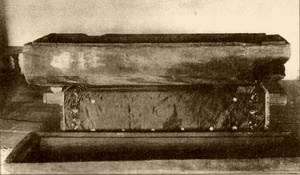 |
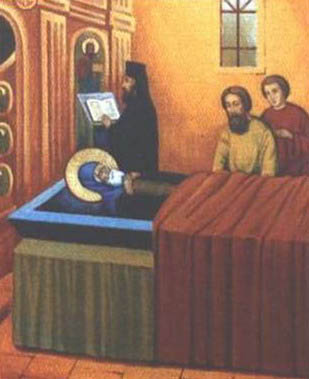 |
The news of his death spread
quickly, and thousands of people gathered from the surrounding provinces.
On the day of his burial there was such a throng of people in the Cathedral
that the candles melted from the heat. St. Seraphim was buried on the south
side of the sanctuary of the Cathedral, beside the grave of the recluse Mark
who died fifteen years before him.

Among others, the following two
miracles are associated with St. Seraphim’s death. On January 2nd,
Abbot Philaret of the Glinsky Monastery of the Mother of God, Province of Kursk
(now the Sumy Oblast, Ukraine), went out of the church after Matins and,
glancing up at the sky, he was astonished to see an extraordinary light. Then
the abbot saw in the spirit what the sign meant and related to those who were
with him: “That is how the souls of the righteous depart. Father Seraphim has
just passed away in Sarov.” Nicholas Motovilov also recorded this in his
memoirs: “On the 2nd of January in the evening I heard from
Archbishop Antony [of Voronezh] that Father Seraphim had passed away on the
previous night at 2 a.m. and that apparently he (St. Seraphim) had himself
appeared to him and informed him of it. On the very same day Archbishop Antony
served a Pannikhida for the Elder with all the Cathedral clergy.”[78]
It should be noted that both the Glinsky Monastery and the Voronezh Cathedral
were hundreds of kilometers away from Sarov, and that, in those days, there was
no physical way for such news to have traveled so fast.
Consecration [79] , [80] , [81]
After the death of St. Seraphim, the flow of pilgrims to
Sarov increased. Many miracles were registered in the Sarov archives, which
were certified by witnesses. Many others were not; it is reported that Sarov
Abbot Hierotheus did not desire to write down the thousands of accounts of help
from the saint—there were simply to many of them. The area surrounding
Sarov was especially full of stories of St. Seraphim and his miracles, and
there was no house wherein a traveler did not hear of “our Batiushka.” From the
moment of his death people began to serve Pannikhidas for him, and icons of his
likeness could be frequently seen. For most people, the sanctity of St.
Seraphim was not in question; it only remained for church authority to
recognize this fact. The first person to officially begin inquiries in this
direction was Archimandrite Raphael, the Sarov superior, ca. 1883; a special
commission gathered materials about Seraphim’s life and miracles, and presented
them to the Tambov Ecclesiastical Consistory. In 1892 the Holy Synod
commissioned an official inquiry into the Staretz’ life and miracles; 28
departments from across all of Russia reported about one hundred miracles that
had been registered. In 1903, Tsar Nicholas II approved a resolution of the
Holy Synod to form another commission under the direction of Metropolitan Vladimir of Moscow. That
the Tsar had a personal interest in seeing that the inquiry be brought to a
conclusion was understandable in that St. Seraphim had long had a special tie
to the Russian Royal Family. The personal relationship between the great-great
uncle of Tsar Nicholas II—that is Tsar Alexander I—has already been
mentioned. Furthermore, Nicholas’ great grandmother Alexandra Feodorovna
(Charlotte of Prussia) received healing due to the intercessions of the saint.
A grand duchess had also been healed through his prayers.
Thus it came about that in January
1903 the commission came to Sarov to proceed with the exhumation of the
Staretz’ body. The cavity was opened and was found to be full of water, but the
oak coffin was reasonably intact. When the coffin was opened, the body of
Seraphim was found therein, still wrapped in his monastic cloak. The bones had
a brownish hue, his hair exhibited a reddish-brown tinge, and his brass cross
rested intact on his breast. The coffin was closed again and tilted to allow
the water to drain away and remains to dry out. On the 5th of July
it was brought to the infirmary church for the ablution of the relics; during
this rite a scent of flowers and honey was noticed. The precious relics were
then placed in an oak coffin that replicated the original.
In preparation for the solemn
glorification of St. Seraphim special preparations were taken by the civil
authorities to handle the expected influx of pilgrims. It should be recognized
that Sarov is located in a remote, dense forest and, at the time, the nearest
village was over 6 km (4 miles) away. Hundreds of huts, rows of shops, and even
supporting chapels, were built along the roads leading into Sarov. Records
indicate that over 200,000 pilgrims came for the services from across the Russian
empire.
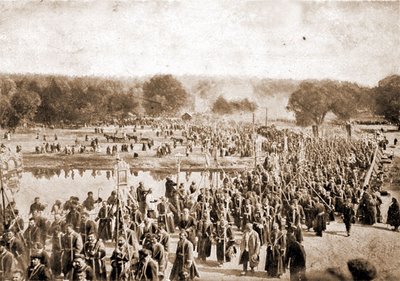
The last Offices for the repose of
Father Seraphim’s soul began at 5 a.m. on July 18th, and at 6 p.m.
the great cathedral bell tolled for the beginning of Vespers, during which the
Staretz was to be glorified as a saint for the first time. This included a
solemn procession where the celebrants, followed by the imperial couple (Tsar
Nicholas-II and Tsarina Alexandra) and all the faithful, made their way from
the cathedral to the infirmary church. The coffin containing the holy relics
was censed, placed on a litter, and borne on the shoulders of bishops, priests,
and the Tsar himself, back into the cathedral.
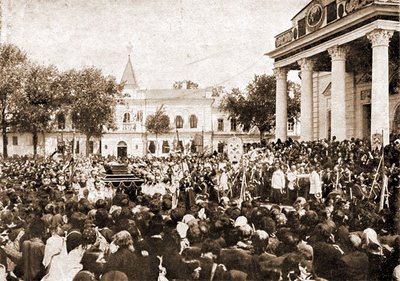
When the office was over the
cathedral was left open all night so that the crowds could approach the coffin.
The next morning, the anniversary of St. Seraphim’s birth, the relics were
placed in a marble shrine with a silver cover bearing seraphim at each corner,
and then a new procession wound through the roads of Sarov.
During the services and processions
associated with St. Seraphim’s glorification, many healings were recorded. It
has also been reported that while the imperial couple were in Sarov on this
occasion, that the Tsarina bathed in the miraculous waters of St. Seraphim’s
spring and prayed to the Saint for the blessing of a son (the Tsarevich Alexei
Nikolaevich Romanov would be conceived later in December of that same year).
Postscript
Twenty years after his canonization, the Soviets occupied
the Sarov monastery and desecrated everything. St. Seraphim’s relics were
placed in a crate and transported off to an anti-religious museum, where they
lay hidden (but not forgotten) for 70 years. In 1990 the relics were found. In
1991, in a 450-mile-long procession they were taken to Diveyevo (Sarov was part
of a security area that was off limits to the general public). Thus another one
of St. Seraphim’s prophecies was fulfilled.
